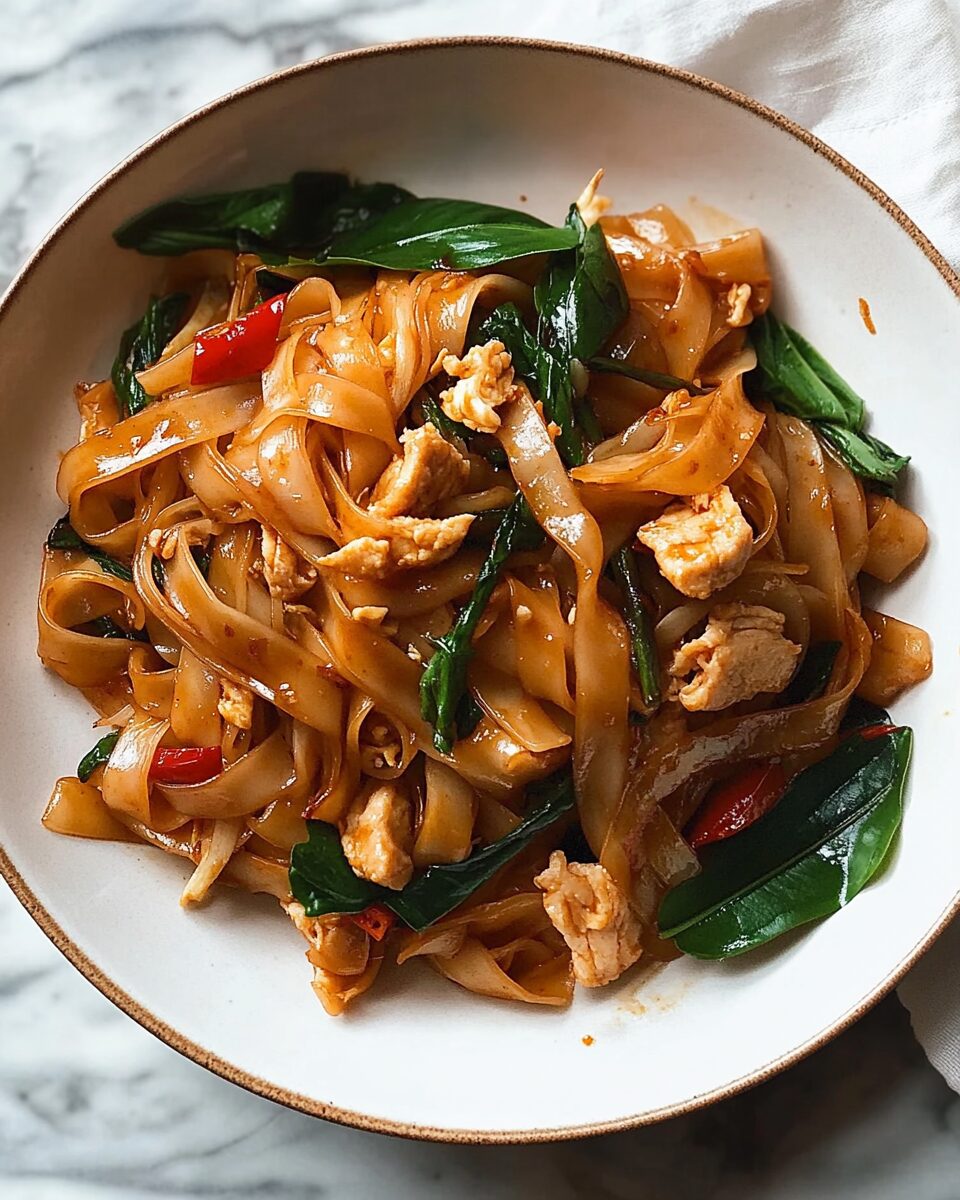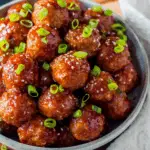Thai Drunken Noodles, or Pad Kee Mao, offer a tantalizing mix of flavors and textures that create an unforgettable dish. The wide rice noodles are stir-fried to perfection with fresh vegetables, eggs, and fragrant Thai basil, delivering a satisfying combination of heat and flavor.
This recipe is easily customizable to suit your taste, allowing you to add your favorite proteins or adjust the spice levels. Whether you enjoy a mild dish or crave something fiery, these noodles can cater to your preference. Perfect for a weeknight dinner or impressing guests at a dinner party, these Spicy Pad Kee Mao will transport your taste buds to the streets of Thailand with every delicious bite.
Full Recipe:
- 8 oz wide rice noodles
- 1 tablespoon vegetable oil
- 3 cloves garlic, minced
- 1 small onion, sliced
- 1 cup bell peppers, sliced
- 1 cup broccoli florets
- 2 eggs, lightly beaten
- 1 cup Thai basil leaves
- 2 tablespoons soy sauce
- 1 tablespoon oyster sauce
- 1 tablespoon chili sauce (adjust for spice preference)
- Salt and pepper to taste
Directions:
- Cook the rice noodles according to package instructions. Drain and set aside.
- Heat vegetable oil in a large wok or frying pan over medium-high heat.
- Add minced garlic and onion; stir-fry for 1-2 minutes until fragrant.
- Toss in the bell peppers and broccoli, cooking for an additional 3-4 minutes until just tender.
- Push the vegetables to one side of the pan, add the beaten eggs, and scramble until fully cooked.
- Add the cooked noodles, Thai basil, soy sauce, oyster sauce, and chili sauce. Stir-fry everything together for 2-3 minutes until heated through and well combined.
- Season with salt and pepper to taste, and serve immediately.
Prep Time: 15 minutes | Cooking Time: 15 minutes | Total Time: 30 minutes | Kcal: 400 kcal | Servings: 2 servings
History and Origin
Pad Kee Mao, often referred to as Thai Drunken Noodles, is a popular dish that originates from Thailand. The name “drunken noodles” is believed to come from the idea that this spicy stir-fry dish is perfect for soaking up alcohol, making it a popular choice among late-night diners. The dish is known for its bold flavors, with a combination of soy sauce, oyster sauce, and chili sauce creating a savory and slightly spicy profile. Traditionally, the dish is made with wide rice noodles, which provide a chewy texture and are excellent for absorbing the sauce.
Key Ingredients
- Wide Rice Noodles: These are the star of the dish, providing a hearty base. They are typically soaked in water to soften them before stir-frying.
- Thai Basil: This aromatic herb is essential for its unique flavor and fragrance, contributing to the dish’s authentic taste.
- Vegetables: Commonly used vegetables include bell peppers and broccoli, but you can also add other options like carrots, snow peas, or baby corn for added texture and nutrition.
- Proteins: While the dish can be made vegetarian, it is often enhanced with protein such as chicken, shrimp, or tofu, making it a versatile meal.
Cooking Tips
- Wok Cooking: For the best results, use a wok to stir-fry the ingredients. The high heat allows for quick cooking, which helps maintain the vegetables’ crispness.
- Noodle Preparation: Make sure to soak the rice noodles according to package instructions. Overcooked noodles can become mushy, so aim for al dente.
- Heat Levels: Adjust the amount of chili sauce to suit your spice tolerance. For a milder version, start with a smaller amount and taste as you go.
Serving Suggestions
Thai Drunken Noodles can be served as a standalone dish or accompanied by a side of fresh spring rolls or a light salad. A squeeze of lime juice just before serving can add a refreshing tang that balances the flavors beautifully.
Nutritional Information
This dish is not only delicious but also nutritious, packed with vegetables and protein. You can make it healthier by incorporating more greens or using less oil when cooking.
Variations of Pad Kee Mao
While the traditional version features wide rice noodles and specific vegetables, many variations exist based on regional preferences and ingredient availability:
- Seafood Version: Substitute chicken with shrimp, squid, or a mix of seafood for a delicious ocean-inspired twist.
- Vegetarian/Vegan Option: Use tofu instead of meat, and ensure that the sauces used (like oyster sauce) are plant-based or substitute with mushroom soy sauce.
- Spicy Drunken Noodles: Increase the amount of fresh chilies or chili paste for a more intense heat. You can also add chili flakes during cooking for extra flavor.
Cultural Significance
In Thailand, street food is an integral part of the culinary culture, and dishes like Pad Kee Mao reflect the lively atmosphere of night markets and roadside stalls. This dish is often enjoyed late at night, highlighting its role in social dining and the country’s vibrant food scene. It’s common to see locals and tourists alike gathering to enjoy these flavors, making it a staple in Thai cuisine.
Pairing Suggestions
To complement Pad Kee Mao, consider serving it with:
- Thai Iced Tea: The sweetness and creaminess of this popular beverage balance the spiciness of the noodles.
- Fresh Spring Rolls: These light and refreshing rolls filled with vegetables and herbs make for a great appetizer.
- Papaya Salad (Som Tum): This tangy salad adds a crunchy contrast and enhances the meal’s overall freshness.
Storage and Reheating
If you have leftovers, store them in an airtight container in the refrigerator. It’s best consumed within 2-3 days. When reheating, use a skillet over medium heat to restore the noodles’ texture, adding a splash of water or broth to prevent sticking.
Health Benefits
Pad Kee Mao can be a healthy choice when made with fresh ingredients and minimal oil. The dish is rich in:
- Vitamins and Minerals: Vegetables like bell peppers and broccoli are packed with vitamins A and C.
- Protein: If you include meat or tofu, the dish becomes a good source of protein, which is essential for muscle repair and overall health.
- Fiber: The inclusion of vegetables contributes to dietary fiber, promoting digestive health.
Cooking Techniques
To ensure a successful stir-fry, consider the following techniques:
- High Heat: Stir-frying at high temperatures helps sear the ingredients quickly, locking in flavors while keeping vegetables crisp.
- Prepping Ingredients: Have all your ingredients prepped and ready to go before you start cooking, as stir-frying happens quickly.
- Add Ingredients Gradually: If using proteins, add them first, followed by harder vegetables, and finish with softer vegetables to ensure everything cooks evenly.
Detailed Cooking Steps
- Noodle Preparation: Soak wide rice noodles in warm water for about 30-45 minutes until soft, then drain and set aside. Alternatively, you can steam them for about 10 minutes for a more authentic texture.
- Marinating Protein: If using chicken, shrimp, or beef, marinate the protein in soy sauce, a dash of oyster sauce, and cornstarch for about 15 minutes. This enhances flavor and tenderness.
- Stir-Frying Techniques: When stir-frying, start by cooking the protein until golden brown, then remove and set aside. Next, stir-fry garlic and onions until fragrant before adding your vegetables. This method layers flavors and ensures each component is perfectly cooked.
Essential Ingredients for Authentic Flavor
To achieve a truly authentic flavor profile for Pad Kee Mao, consider incorporating the following ingredients:
- Dark Soy Sauce: Adds a rich color and deep flavor; can be used in conjunction with regular soy sauce.
- Oyster Sauce: Gives a savory depth and enhances umami flavor.
- Fish Sauce: A key ingredient in Thai cooking, adding saltiness and complexity.
- Sugar: A small amount balances the saltiness and spiciness in the dish, creating a well-rounded flavor.
Serving Presentation
The presentation of Pad Kee Mao is important for enhancing the dining experience. Consider these tips:
- Garnishes: Top the dish with fresh Thai basil leaves and lime wedges for a burst of color and flavor.
- Serving Style: Serve in a large bowl or plate, making sure the noodles are twirled elegantly, and the protein and vegetables are arranged on top.
- Accompaniments: Offer additional lime wedges and chili flakes on the side, allowing guests to adjust the flavors to their liking.
Ingredient Substitutions
For those who may have dietary restrictions or preferences, here are some substitutions:
- Gluten-Free: Use gluten-free soy sauce instead of regular soy sauce.
- Low-Carb Option: Substitute rice noodles with zucchini noodles or shirataki noodles for a low-carb alternative.
- Spice Level: Adjust the amount of chili paste or fresh chilies based on personal preference; you can also omit them for a milder dish.
Popular Variations Around the World
Pad Kee Mao has inspired several international adaptations:
- American Version: In some American Thai restaurants, the dish may include more vegetables and a sweeter sauce to cater to local tastes.
- Fusion Variants: Some chefs combine Pad Kee Mao with other cuisines, such as adding elements from Italian pasta dishes, like parmesan cheese, for a unique twist.
Pairing Wine or Beverages
When enjoying Pad Kee Mao, consider pairing it with:
- Wines: A crisp Sauvignon Blanc or a light-bodied Riesling complements the spiciness and richness of the dish.
- Beers: A Thai lager or light pilsner is refreshing and can help balance the heat.
- Cocktails: A sweet and tangy cocktail, like a mojito, can enhance the meal’s flavors and provide a refreshing contrast.
Cultural Influences
Pad Kee Mao is influenced by various cultures due to Thailand’s geographical location and history. The dish reflects:
- Chinese Influence: Stir-frying is a technique rooted in Chinese cuisine, which has been adopted and adapted by Thai cooks.
- Local Ingredients: The use of fresh herbs, spices, and vegetables showcases Thailand’s rich agricultural landscape and its importance in traditional cooking.
Nutritional Considerations
When made with fresh ingredients, Pad Kee Mao can fit well into a balanced diet:
- Balanced Meal: Provides carbohydrates from noodles, protein from meat or tofu, and a variety of vitamins and minerals from vegetables.
- Caloric Content: While delicious, be mindful of portion sizes and sauce quantities if you’re monitoring caloric intake, as the dish can be rich.
Conclusion
Pad Kee Mao is more than just a meal; it’s a celebration of flavors, textures, and cultural heritage. Whether you’re cooking it for a casual dinner or a special occasion, this dish is sure to impress with its vibrant colors and bold flavors. As you prepare your version of Pad Kee Mao, embrace the creativity it offers and make it your own, exploring the vast world of Thai culinary traditions.






